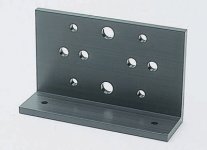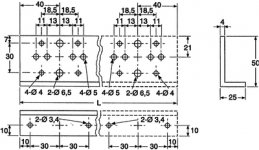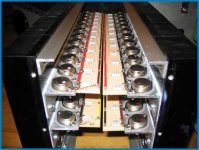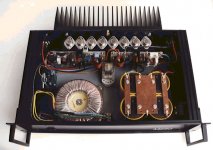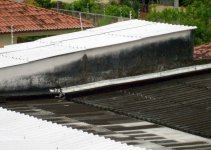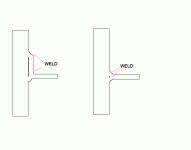Most of my amps are based on L shape 4.5mm aluminioum corner that then is attached to the heatsink with bolts and screws ......
In between always and of course is as much paste is possible to ensure better heat transfer from one element to the other.
(Many times crossed my mind to make my own paste made out of the normal white paste we buy at the hardware shops but mixed with aluminioum powder which i can have plenty from local aluminioum shops . Never tryied that but sounds like a good idea )
One other thing i know very well is that not all L shape aluminioum is good to be a heatsink since it is very importand what material is actually made of .
And finally specially made L shape are sold in shops with the iner corner rounded which quicker transfers heat to the main heatsink.
The idea crossed my mind lately is to weld the L to the main heatsink ......since i can do that now i will give it a try and let you know .
In between idlike to listen to your opinion about that
one will say why not buy ready made heatsink that is already shaped to meet your standards ....Then i have to answer that i have so much hetasink in my shop from various projects that i have to convert to fit any amp i construct, and also there is so much heatsink from classic 2N3055 style transistors and i really like to make this usefull again by welding parts on it so it can be used for other devices also
In between always and of course is as much paste is possible to ensure better heat transfer from one element to the other.
(Many times crossed my mind to make my own paste made out of the normal white paste we buy at the hardware shops but mixed with aluminioum powder which i can have plenty from local aluminioum shops . Never tryied that but sounds like a good idea )
One other thing i know very well is that not all L shape aluminioum is good to be a heatsink since it is very importand what material is actually made of .
And finally specially made L shape are sold in shops with the iner corner rounded which quicker transfers heat to the main heatsink.
The idea crossed my mind lately is to weld the L to the main heatsink ......since i can do that now i will give it a try and let you know .
In between idlike to listen to your opinion about that
one will say why not buy ready made heatsink that is already shaped to meet your standards ....Then i have to answer that i have so much hetasink in my shop from various projects that i have to convert to fit any amp i construct, and also there is so much heatsink from classic 2N3055 style transistors and i really like to make this usefull again by welding parts on it so it can be used for other devices also
good idea, sakis
how is thing in greece & makedonia ...
Using L-shaped aluminum bars has been used many times
for TO-3 devices this is one of the best ways
in my country of sweden, and in other parts of EUROPE,
www.elfa.se
they sell the follwing special bars
specially made for TO-3 or other transistors
They come in two lengths:
- 80 mm wide, either drilled for 2 x TO-3
or not drilled any holes
- 160 mm wide, predirlled for 4 x TO-3
or un-drilled
how is thing in greece & makedonia ...
Using L-shaped aluminum bars has been used many times
for TO-3 devices this is one of the best ways
in my country of sweden, and in other parts of EUROPE,
www.elfa.se
they sell the follwing special bars
specially made for TO-3 or other transistors
They come in two lengths:
- 80 mm wide, either drilled for 2 x TO-3
or not drilled any holes
- 160 mm wide, predirlled for 4 x TO-3
or un-drilled
Attachments
These are the dimension
of the L-shaped brackets.
These www.elfa.se will sell to anyone in Europe.
of the L-shaped brackets.
These www.elfa.se will sell to anyone in Europe.
Manufacturer: Austerlitz
L shape bracket to provide heat conducting connection between transistors and heatsink. Undrilled, or drilled for transistors and heatsink.
Material: Aluminium, black anodised.
ELFA is one of the largest catalogue distributors of electronics in Northern Europe
ELFA's experience as an electronics supplier spans 60 years.
The concept of simple ordering and fast and reliable delivery, in combination with an active development of our assortment and extensive technical advise, has made this company into one of the largest catalogue distributors of electronics in northern Europe.
ELFA is owned by the Swiss industry concern Dätwyler.
Our business area includes Sweden, Norway, Denmark, Finland
and Poland, the Baltic States and the Ukraine.
In a further ten European countries ELFA is represented by resellers.
One supplier — more than 65 000 products
ELFA offers a wide selection of the latest news as well as more unusual products. We co-operate with about 650 leading suppliers across the world, selecting products that meet our customers' needs.
Attachments
thanks line up
all is fine here ..... i actually visited this shop in person i think it should be located in a place called solna but may be i am wrong .....( i visited in 1994)
A think i didnt like about the shop is that works with catalogs and a piece of paper that you write down numbers from the catalog and then somebody will bring it out from the stock .....
Shoping parts in greece is a totaly diferent game .....In the shops you go the "tellers" are edjucated and highly expirienced people in electronics and they know replacements by hurt ( often they dont need to open a book ) then you can also talk about the quality or specs of the product and of course and more importand there you will meet others that share simular needs ,problems, and so on .....so you can talk about your project there ......
May be takes more time but hell !!! shoping is much more fun like that
all is fine here ..... i actually visited this shop in person i think it should be located in a place called solna but may be i am wrong .....( i visited in 1994)
A think i didnt like about the shop is that works with catalogs and a piece of paper that you write down numbers from the catalog and then somebody will bring it out from the stock .....
Shoping parts in greece is a totaly diferent game .....In the shops you go the "tellers" are edjucated and highly expirienced people in electronics and they know replacements by hurt ( often they dont need to open a book ) then you can also talk about the quality or specs of the product and of course and more importand there you will meet others that share simular needs ,problems, and so on .....so you can talk about your project there ......
May be takes more time but hell !!! shoping is much more fun like that
Sakis,
throw out the L bracket - it adds additiopnal thermal resistance that is not needed and there is a more elegant way of solving this problem.
1. Use TO247 style or TO220 output devices
2. Mount the devices between the PCB and the heatsink.
This solves a lot of mechanical issues and is a quick and neat way to assemble
throw out the L bracket - it adds additiopnal thermal resistance that is not needed and there is a more elegant way of solving this problem.
1. Use TO247 style or TO220 output devices
2. Mount the devices between the PCB and the heatsink.
This solves a lot of mechanical issues and is a quick and neat way to assemble
thanks bonsai
most times i look at your posts there is always a usefull comment or information .....
this is ok if you need to construct one amp then you had the chance to design like this which is not a bad idea ( but actually eventhough seen it before i have second thoughts on what happens to the pcb if the transistors warm up more than they suppose to ****read my signature *****)
in my case i have right infront of me .....today about 15 amps either to be repaired reconstructed ....others constructed from scratch ....some of them are mine and they are to be repaired and then back to work in small PA rentals that i deal with and then some more amplifiers that are constructed for costumers on special demands and requests .... and a couple of projects that are other peoples ideas which i mod to my taste ....
so with all this volume of work and also all this stock of various heat sink the ability of flexible is a must .....
i ll post pictures any day now about this ....but first i need to make thermo tests
the question remains :
if the L shape will perform beter with paste bolts and screws or welding
most times i look at your posts there is always a usefull comment or information .....
this is ok if you need to construct one amp then you had the chance to design like this which is not a bad idea ( but actually eventhough seen it before i have second thoughts on what happens to the pcb if the transistors warm up more than they suppose to ****read my signature *****)
in my case i have right infront of me .....today about 15 amps either to be repaired reconstructed ....others constructed from scratch ....some of them are mine and they are to be repaired and then back to work in small PA rentals that i deal with and then some more amplifiers that are constructed for costumers on special demands and requests .... and a couple of projects that are other peoples ideas which i mod to my taste ....
so with all this volume of work and also all this stock of various heat sink the ability of flexible is a must .....
i ll post pictures any day now about this ....but first i need to make thermo tests
the question remains :
if the L shape will perform beter with paste bolts and screws or welding
Sakis, you make a mistake if you apply too thick paste...
The easiest way to show you is to do it on a computer CPU chip... as it has digital temperature tracking on your screen...
The trick is to use a high quality thermal compound... the quality computer brands do very well...in terms of how long it lasts, espicialy when applied as thin as possible as per recommendation...
If you can make a copper mounting plaste I suggest you try Coollaboratory Liquid Pro, it will eat aluminium if it gets in contact with it though... this stiuff has 10 times the thermal transfer rate of traditional thermal compounds...
The easiest way to show you is to do it on a computer CPU chip... as it has digital temperature tracking on your screen...
The trick is to use a high quality thermal compound... the quality computer brands do very well...in terms of how long it lasts, espicialy when applied as thin as possible as per recommendation...
If you can make a copper mounting plaste I suggest you try Coollaboratory Liquid Pro, it will eat aluminium if it gets in contact with it though... this stiuff has 10 times the thermal transfer rate of traditional thermal compounds...
Re: thanks bonsai
Welding aluminum is tricky - you need shielding gas and the parts need to be heated up before you start or they could warp.
If you can weld aluminum cleanly, welding will be the best way. Welding would connect the metal parts together without a joint between, just continuous metal.
sakis said:
if the L shape will perform beter with paste bolts and screws or welding
Welding aluminum is tricky - you need shielding gas and the parts need to be heated up before you start or they could warp.
If you can weld aluminum cleanly, welding will be the best way. Welding would connect the metal parts together without a joint between, just continuous metal.
Bonsai said:throw out the L bracket - it adds additiopnal thermal resistance that is not needed and there is a more elegant way of solving this problem.
1. Use TO247 style or TO220 output devices
2. Mount the devices between the PCB and the heatsink.
This solves a lot of mechanical issues and is a quick and neat way to assemble
this is the road most diy builder takes
TO247 or similar are most popular cases
Nelson Pass has told me once he was in favour of TO3.
I prefer TO3.
A ot of constant heat Class A amplifiers are thing me and Mr. Pass have in common.
1. Metal Case TO3 have max Tj=200 C
while Plastic case TO247 most are max Tj=150
This means an extra 50 C temp margin if use TO3.
2. Nelson Pass pointed out that TO3 metal, with 2 screws
are not sensitive to if you fasten screws TOO TIGHT.
They are mechnical robust, in compare to plastic cases, like TO247.
So they are not as easily mechanically destroyed.
In most plastic case transistors, with only one hole,
you can cause internal damage to the package ,
if you use too much force to fasten the transistor.
This of course one issue with TO126 (BD139 etc).
But also TO220 & TO247 variants needs special care to draw your screws
with proper momentus of force. Not too much .. not to little.
3. Two screws are better than one, fitting a big transistor tight and distribute the pressure.
As this puts the pressure more all over the backside of transistor
that is to be in full contact with heatsink.
----------------
Now, for Class AB moderate power and lower Class A idle power,
it is no big deal using TO247 .. there are some rugged such.
And you can use very large heatsinks instead + parallel devces if you wish.
IRF240 / IRF9240, for example, has got this 50 C degrees lower.
Max junction of 'only' 150 C.
Nelson Pass uses them
Maybe because he has learnt DIY Audio people prefer PLASTICS
But if you are purist & not want to paralell + you want to use higher amount of idle power,
for higher output in Class A (or very high power Class AB)
then TO3 is one way to go.
I can recommend this.
And in this TO3 case it is nice to be able to attach TO3 devices
using these L-Shaped bars.
Anyone that has drilled very big heatsinks, for TO3 .. will know
Lineup Transistor Choice service for home builders
Lineup
Pass DIY A75 build mount of TO3
here you have an example
what can be done with TO3 METALLIC HOUSING power transistors
Nelson Pass DIY, A75 power amplifier:
http://www.passdiy.com/gallery-misc-framed-leftframe.htm#A75
Lineup
here you have an example
what can be done with TO3 METALLIC HOUSING power transistors
Nelson Pass DIY, A75 power amplifier:
http://www.passdiy.com/gallery-misc-framed-leftframe.htm#A75
Lineup
Attachments
Lots of good ideas here. Bear in mind that you need to ensure good thermal contact over the entire length of the angle bracket if that is what you are using. Extrusions are not as flat as you think and some enthusiasts go as far as surface grinding the mating surfaces to ensure flatness and hence good contact. Proper placement of the mounting screws and torquing of the screws can also greatly affect thermal transfer. One system I have seen for mounting plastic-cased power transisors is to use a mounting bar above the transistir body with screws either side of the transistor. This increases the bearing area and thus improves case to heatsink heat transfer. You don't crack the plastic case by over-tightening mounting screws but all of the transistors come loose when you remove the mounting bar. There is no free lunch here!
An alternative approach to mounting power transistors that removes the above problems but creates other ones is to use a heatsink with an integral flange for mounting transistors. Conrad offer one and two flange heatsinks as I am sure do other manufacturers. The advantage of integral flanges is the removal of an interface and the massive improvement in thermal transfer. Disdvantages include the increased difficulty in accurately drilling holes for mounting screws, potential damage to the heatsink when you are marking and drilling the holes, and the possible increased difficulty when removing or replacing components.
An alternative approach to mounting power transistors that removes the above problems but creates other ones is to use a heatsink with an integral flange for mounting transistors. Conrad offer one and two flange heatsinks as I am sure do other manufacturers. The advantage of integral flanges is the removal of an interface and the massive improvement in thermal transfer. Disdvantages include the increased difficulty in accurately drilling holes for mounting screws, potential damage to the heatsink when you are marking and drilling the holes, and the possible increased difficulty when removing or replacing components.
Re: Re: thanks bonsai
If it's not a full pen weld then there will be an air/gas gap between the faces.
If a flange is attached to the face of the heatsink then full pen can be achieved, but we still have to contend with the difficulties of distortion free aluminium welding.
However, the thermal conduction path of a welded flange is considerably smaller than the thermal path of a bolted face.
Test it to find out which is better.
one cannot achieve a full penetration weld when attaching the face of an L bracket to the face of a heatsink.MJL21193 said:Welding would connect the metal parts together without a joint between, just continuous metal.
If it's not a full pen weld then there will be an air/gas gap between the faces.
If a flange is attached to the face of the heatsink then full pen can be achieved, but we still have to contend with the difficulties of distortion free aluminium welding.
However, the thermal conduction path of a welded flange is considerably smaller than the thermal path of a bolted face.
Test it to find out which is better.
sakis said:paste bolts and screws or welding
add a number of mounting holes and use rivets instead of screws.
You're lucky you have "L" shape aluminium into your shops.
Real aluminium is nice to conduct electricity and heat.
Here i can easily find L profile used to build doors and window frames... and those ones are not really aluminium...they are hard.. alike the ones used into airplanes bodies... those ones do not conduct heat very well...you install transistors and you have a hot spot around the transistor when the metal extreme points are cold.... there's not only a big delay into thermal conduction but also the heat transference is not good.
Those aluminium are called here "duraluminium"...hard aluminium...they are not flexible alike aluminium...not good to conductivity of electricity and heat.
You are lucky your country is rich.... i have not... only thin aluminium that is old to roof borders...they cover the walls into the roof... they are thing and easy to bent using hammer.
In the picture you see one application used here to thin, flexible, good aluminium... real aluminium...pure aluminium... to drain water out from this roof.
regards,
Carlos
Real aluminium is nice to conduct electricity and heat.
Here i can easily find L profile used to build doors and window frames... and those ones are not really aluminium...they are hard.. alike the ones used into airplanes bodies... those ones do not conduct heat very well...you install transistors and you have a hot spot around the transistor when the metal extreme points are cold.... there's not only a big delay into thermal conduction but also the heat transference is not good.
Those aluminium are called here "duraluminium"...hard aluminium...they are not flexible alike aluminium...not good to conductivity of electricity and heat.
You are lucky your country is rich.... i have not... only thin aluminium that is old to roof borders...they cover the walls into the roof... they are thing and easy to bent using hammer.
In the picture you see one application used here to thin, flexible, good aluminium... real aluminium...pure aluminium... to drain water out from this roof.
regards,
Carlos
Attachments
Re: Re: Re: thanks bonsai
Hi Andrew,
It doesn't need to be to be better than the bolt-on. The welded area need only be as thick as the thin profile of the angle itself. Conduction of any energy is only as efficient as the weakest link in the chain, in this case, the thinest section of the angle.
Instead of welding an angle, weld a flat piece perpendicular to the face of the heatsink. See illustration:
AndrewT said:one cannot achieve a full penetration weld when attaching the face of an L bracket to the face of a heatsink.
If it's not a full pen weld then there will be an air/gas gap between the faces.
If a flange is attached to the face of the heatsink then full pen can be achieved, but we still have to contend with the difficulties of distortion free aluminium welding.
However, the thermal conduction path of a welded flange is considerably smaller than the thermal path of a bolted face.
Test it to find out which is better.
Hi Andrew,
It doesn't need to be to be better than the bolt-on. The welded area need only be as thick as the thin profile of the angle itself. Conduction of any energy is only as efficient as the weakest link in the chain, in this case, the thinest section of the angle.
Instead of welding an angle, weld a flat piece perpendicular to the face of the heatsink. See illustration:
Attachments
- Status
- This old topic is closed. If you want to reopen this topic, contact a moderator using the "Report Post" button.
- Home
- Amplifiers
- Solid State
- heatsink idea
